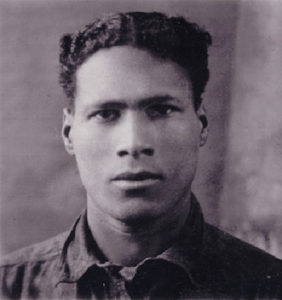
William Jonhson, 1912, image by Steve Turner
*On this date, we remember the birth of William Henry Johnson in 1901. He was a Black artist who worked primarily as a painter.
From Florence, South Carolina, his mother was of Black and Native American (Sioux) ancestry. His father was a prominent white man in the area who did nothing toward his son’s upbringing. His mother eventually married a Black man who worked on behalf of the family until an accident disabled him. Young Johnson worked odd jobs to help his mother with family needs, carrying lunch pails of food to the railroad yard and the sharecropping fields during spring planting. Also, at an early age, he discovered that he could draw well.
His teachers who saw his work gave him paper and pencils, though Johnson quit school in his teens. Wanting to go to New York to study art, he accompanied his uncle, who was searching for better wages. In 1921, Johnson began a traditional art education at New York’s National Academy of Design. There, he won the Cannon Prize in 1924 and again in 1926. He also won the Hallgarten Prize in 1925 before embarking on the life of an expatriate in France in 1926. In Europe, he discarded artistic and academic etiquette in favor of a tempestuous and heavily impasto manner strongly influenced by European Expressionism. Landscapes and still lives were his passion.
He married Holcha Krake, a white weaver, in 1930, and the couple spent the next eight years in rural Denmark and Norway, taking trips across Europe and Tunisia. Some of his works included Self Portrait (1929) and Minnie and Girl in a Red Dress (1936). In 1938, to escape the rise of Nazism, Johnson and his wife moved to New York. Johnson found the adjustment to life in America difficult; hostility towards his interracial marriage and the worsening depression were not easy realities to live with. Still, his focus shifted to the figure and themes of Black life, which he recalled from his southern childhood and his observations of Harlem.
The new style was administered with gentle humor and religious sentiment; this representation can be seen in Fletcher (1939) and Chain Gang (1942). Following Holcha’s death in 1944, Johnson returned alone to Scandinavia, but the onset of degenerative brain disease in 1947 forced him to return to New York and his institutionalization. The art in his possession was placed in a warehouse, and he languished in a state hospital on Long Island for 22 years until he died in 1970.
The St. James Guide to Black Artist
Edited by Thomas Riggs
Copyright 1997, St. James Press, Detroit, MI
ISBN 1-55862-220-9